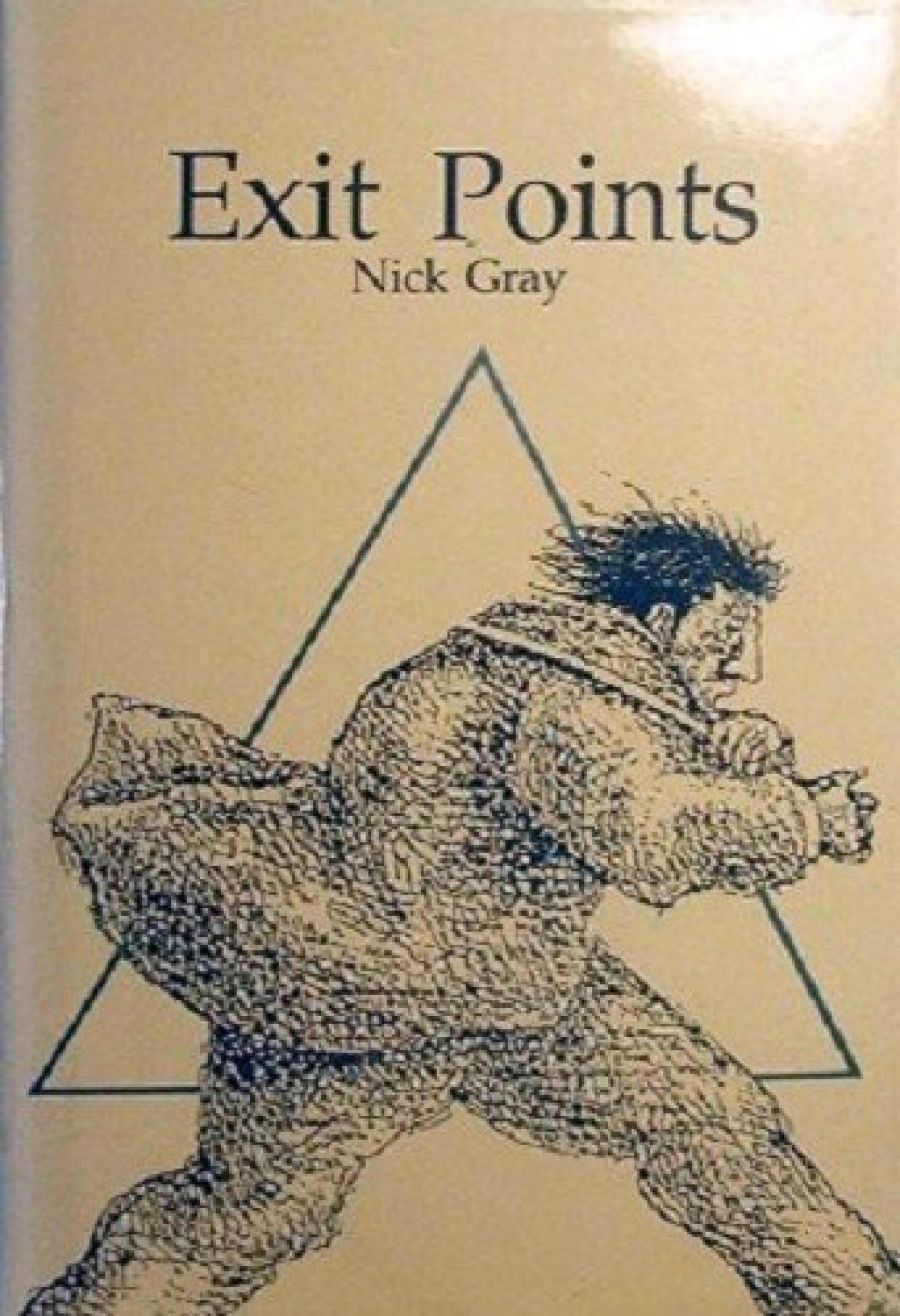
- Free Article: No
- Contents Category: Fiction
- Review Article: Yes
- Online Only: No
- Custom Highlight Text:
As novels such as Lucky Jim attest, universities provide a fertile setting for excursions into bizarre humour. Even at the best of times they seem somewhat divorced from reality, so sending them further off the planet by depicting them through the jaundiced eye of satiric exaggeration fits nicely.
Exit Points by Nick Gray is set in a university. But it is not about tertiary education as such. The novel – often hilarious, usually funny, sometimes ludicrous – is an extravagant attack on the structures of reality, undertaken in an academic context for the reasons I’ve already suggested. Like Alice in Wonderland – towards which it nods deferentially – Exit Points digs a way at ordinary human assumptions until the reader is dropped into the chaos of thoroughly enjoyable nonsense. But, as in Alice, we remain aware that reality is the real issue here, even though its structure might be utterly discredited.
- Book 1 Title: Exit Points
- Book 1 Biblio: Brolga Press, 218 pp, $19.95 hb
Exit Points postulates two fantastical elements: an institution called Capricorn University, and the existence of ‘exit points’ – places where death occurs if someone (or something) happens to be there when it becomes ‘activated’. Capricorn University is the product of architect Kurt Boedlerr’s belief that he was working for the Pharaohs – it is the ‘most monumental product of his post-psychotic period’. The theoretical existence of ‘exit points’, on the other hand, is postulated by an entrepreneurial student named Felix – described as a ‘dangerously unpredictable individual with severe personality disorders’. Felix believes that if he can map all exit points he will be able to live forever by arduously avoiding them.
The two things – Capricorn Uni and the theory of exit points – come together not only because Felix is a research student at Capricorn, but because the university appears to be built over a very large exit point. This no doubt explains why this particular institution doesn’t appear in the Guide to Australian Universities.
The protagonist (and first-person narrator) of Exit Points is James Noone, who has enrolled in Capricorn Uni as a way of exiting from a previous life (and a tragic relationship with Miranda, who eventually re-enters the story and provides a rather messianic, and surprising, climax to it). From the start Noone seemed doomed. Everything goes wrong: the university proves to be a place where meaning is tenuous, real human relationships almost non-existent and study is rare.
The university itself is an Escher-like network of passages and irrational spaces, mostly devoid of human life. It’s like something out of Kafka. Step out of line – which Noone does by association with Felix – and you are likely to be visited by the Tactical Response Attack Group, who will probably chainsaw your room. You could go to a lecture or two, or if you could work out where and when they were held. But try to relate to the place in a meaningful way and you’re doomed for sure.
Hence, the world of Exit Points is a surreal and wholly bizarre place. Coincidence is inevitable, and everything ties together neatly at the end. The fact that Noone was conceived at the moment when his father was struck and killed by ightning (thus giving Noone a terrible fear of thunderstorms) is odd enough, but in the world of this novel it shouldn’t surprise you that it proves to be crucial.
In this sort of novel, characters tend to become caricatures. To my mind it doesn’t matter too much. They serve a sort of amusing function. One such exaggeration is the surprisingly named Flem Paddock – a violent, erratic, feral monster – motivated by fury ver the moral corruption of his big-bosomed stepdaughter, Penny. Felix, too, is something of a caricature (though less so), as is the lecherous and psychotic English professor M.X. Plutum.
The narrator himself is real enough to engage our sympathy – at least so that we don’t mind being in his head for the duration. There is a tendency for his lack of initiative to become frustrating, but that’s a function of this sort of anarchic humour, which likes to propel an innocent into the thick of things and then bombard him with disaster. Anyway, Noone does ‘act’ eventually, thus overcoming several of his problems, and providing a re-birth affecting Noone’s fate and possibly the world’s.
Nick Gray’s previous work has all been in the theatre. Not surprisingly, therefore, dialogue is one of this book’s strongest points. Much of the thematic action is carried by the dialogue, and even the narration works as speech. Perhaps, too, this is why most of the novel is written in the present tense – a foible which might annoy some readers, since the narration sounds like stage directions in a playscript.
A tone of absurdity on the one hand and the implied seriousness on the other are difficult to balance. Sometimes the nonsensical humour of Exit Points tips over into the merely absurd and ceases to be funny. But Gray was obviously enjoying himself and that helps the reader enjoy it too. He manages to pace both incident and emotion so that the super-reality which makes coincidence such a dominating factor becomes acceptable, and provides for a culmination in theme towards the end.
All told, this is a satisfying novel, though still suffering from some of the naïve excesses of first novels. Published by a Canberra-based small press, Brolga Press, Exit Points is a handsome hardcover edition, well made and pleasant to handle. Though it could have used a more professional final proofing, it is a fine-looking and entertaining book.


Comments powered by CComment